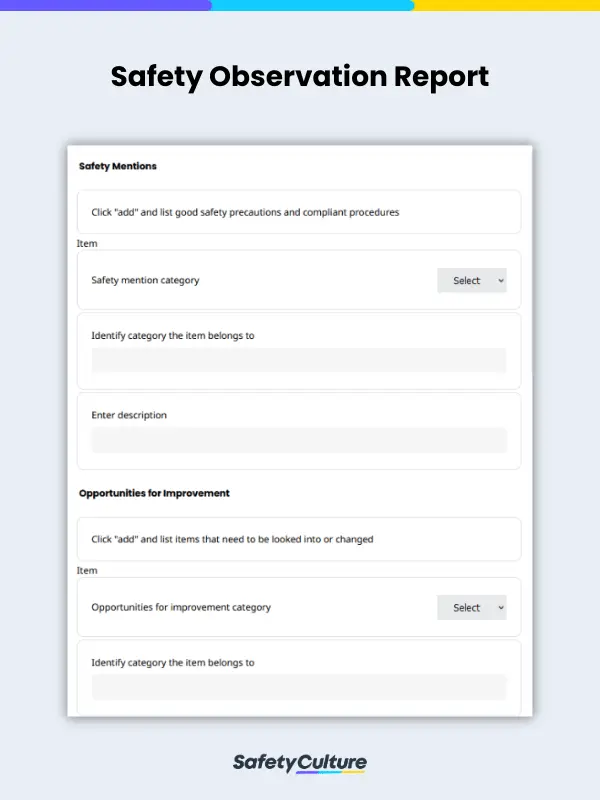What is a Safety Observation Report?
A safety observation report is a tool used by safety officers to document hazards as well as safety commendations in the workplace. Performing and documenting regular safety observations can help organizations proactively identify and address safety concerns, prevent incidents and ultimately foster a safer work environment.
5 Tips for Writing Safety Observations in the Workplace
A good safety observation report should be comprehensive and provide the details needed by the organization for future improvements on health and safety in the workplace. In writing safety observations, the following tips can be used to effectively produce a comprehensive report. These tips are applied before and during the process of writing observation reports:
Identify what to observe
The first step to writing a safety observation is to determine its focus. Safety observations are done by observing common areas, equipment, or procedures in the workplace that can affect the health and safety of employees. Different workplace industries require different key areas of focus when it comes to safety. However, here are the important categories to inspect when performing a safety observation for any given workplace:
- Common Working Areas
These are areas where workers spend most of their time either working or passing through. A safe and tidy working area can minimize the risk of employee injury, health hazards, and productivity loss.- What to check: lighting, accessibility, temperature, humidity, dry floor/ even pavement, no sharp edges of work tables or chairs, appropriate work tools, and ergonomics.
- Personal Protective Equipment (PPE)
PPE is used to protect employees from physical harm. Not wearing or wearing damaged equipment may lead to serious injury.- What to check: availability, condition, and appropriateness of PPEs, damage, the ratio of employees vs available PPE, and training.
- Fire Safety Equipment and Procedures
Safety equipment and procedures must be available and accessible at all times to employees in case of fire-related emergencies.- What to check: fire extinguishers, evacuation posters, fire drills, first aid kits, emergency lighting, sprinklers, fire alarms, and emergency exits.
- Electrical Hazards
Faulty and messy wiring can cause trip hazards, fire, electrocution, and property damage.- What to check: wiring, outlet locations, extension cords, and electric equipment.
- Proper Storage
Proper storage of documents, materials, and equipment can minimize trip hazards and injuries from manual handling.- What to check: tidiness, appropriate signage, proper location storage, and ergonomic manual handling.
Indicate the timeframe of the observation
Another thing to consider when writing down an observation report is the timeframe. Observations can run for a day, a month, or more. Deciding the timeframe will vary depending on the focus of your observation and how much data is needed to quantify and understand the results of your observation.
Pay Attention to Details and Take Notes
Focus on the area or equipment and see if there are any changes during the given timeframe of the observation. Note down notable impressions as you do the observation to ensure the accuracy of the information in your observation report.
Support with evidence
The quality of observation reports can be enhanced through multimedia such as photos, videos, or audio recordings. The most commonly used among these are photographs, as they are easy to capture and attach to the reports. Support observation reports with photographs to effectively capture and illustrate significant findings during observation.
Use tools
A common question about safety observation is “what form is used to record safety observations in the workplace?”. There are various tools and resources available that can help in conducting observations and writing down reports. Many of these tools are now digital which can help in simplifying and streamlining the whole observation process. We have collected safety observation report templates that are downloadable and customizable according to workplace safety observation needs.
Safety Observations Examples
Some examples of safety observations in the workplace include monitoring noise levels to protect against hearing damage, checking for proper ventilation to prevent exposure to hazardous chemicals or fumes, observing workers’ posture and ergonomics to prevent repetitive stress injuries, and assessing employee behavior while performing tasks to identify unsafe practices.
Safety observations are done for a variety of reasons but their main goal is to proactively identify any potential hazards and maintain a safe working environment for businesses.
How to Complete a Safety Observation Report?
Begin your safety observation by critically examining key areas of your workplace (examples above) and identify them according to the following:
- Safety Mentions
Identify what is being done correctly in terms of safety. These observations should be based on best practices, encouraged and shared with other teams. - Opportunity for Improvement
Identify observations that could benefit from best practices or safety ideas you may have. These items do not pose an immediate safety risk but could be improved to further defenses or improve processes and communication. - Critical Item
Identify areas that pose risk of injury or harm to workers. These items should be addressed immediately and communicated directly to the office manager and relevant teams.
Include a brief description of the safety observation and photo evidence with a detailed caption. A summary of recommendations and needed corrective measures are also included in the report to address all areas important to health and safety. Click here to preview a completed safety observation example report.



